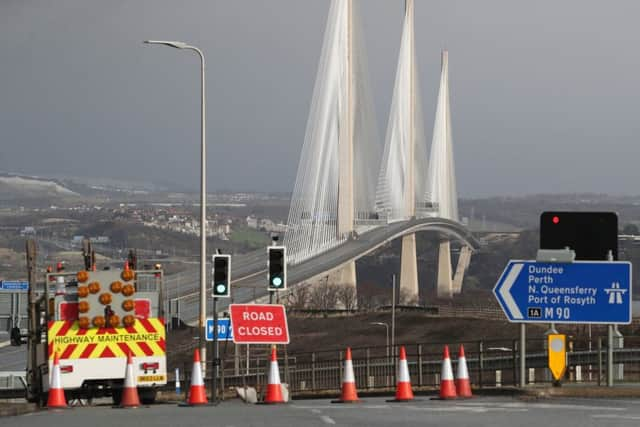SNP ‘dragging its feet’ over ice sensors on Queensferry Crossing
A final procurement report on specialist equipment capable of detecting ice accumulations on the bridge will not be completed until the end of the month – some four months after transport secretary Michael Matheson told Holyrood they would be fitted.
It comes as Transport Scotland confirmed the replacement of the main expansion joints on the Forth Road Bridge – work that has ruled out its use as a contingency for general traffic in the event of more closures on the £1.35 billion crossing – will not be completed until the summer.
Advertisement
Hide AdAdvertisement
Hide AdThe crossing’s operating company, Amey, has said “pro-active monitoring” will continue after the bridge reopened at 10:45am yesterday.


The firm said its engineers were “confident” the risk of further ice build-up had passed.
The closure was prompted by ice falling from the bridge’s cables, which damaged a total of eight vehicles.
A build-up of ice on the crossing’s towers and cables was said to have formed in “unique weather conditions” following Storm Ciara.
Motorists had to cross the Forth via the Kincardine Bridge – a 34-mile diversion – due to the closure. Further snow and ice was recorded falling during the period the bridge was shut to traffic.
Amey’s account director Mark Arndt said the data it gathered had “improved our understanding” of the issue and would help the company to improve predictions and refine operating procedures in the future.
Shirley Anne Somerville, the SNP MSP for Dunfermline and West Fife, said she had spoken to Mr Matheson yesterday regarding the role of the Forth Road Bridge as a contingency.
She explained it “wasn’t possible” due to major work, but that Mr Matheson had “instructed officials to look at what can be put in place to ensure it is available in the future should this situation arise again”.
Advertisement
Hide AdAdvertisement
Hide AdMr Matheson had conceded on Tuesday – the second day of the Queensferry Crossing’s closure – that the two-and-a-half-year-old bridge may have to shut again due to adverse weather before a solution was found. The Scottish Conservatives questioned the monitoring regime on the crossing, pointing out that Mr Matheson promised in October last year that ice sensors would be installed.
That pledge came seven months after three vehicles had their windscreens smashed by ice, but Mr Matheson stressed the conditions that could lead to a build-up of ice were “very rare” in the Forth estuary.
Miles Briggs, the Scottish Conservatives MSP for Lothian, said: “We’ve been putting pressure on the SNP government for several months over ice sensors, and these admissions expose just how badly it has dragged its feet.
“It’s clear the transport minister dismissed the ice incidents of March last year as, in his words, extremely rare, and not worth addressing with any urgency.
“That complacency has now brought havoc for commuters and businesses on both sides of the Forth, and is yet more proof of another devolved area which the nationalists are driving into the ground. The SNP planned, commissioned and constructed this crossing. Now that these problems have been uncovered, they must take full responsibility.”
A spokesman for Transport Scotland said the safety of road users was its “number one priority”, adding: “Looking ahead we will implement comprehensive monitoring of the Queensferry Crossing, when similar weather conditions are expected, with a particular focus on the areas we now know as vulnerable to this ice accumulation.
“We are also taking steps to improve our traffic management response to any incidents so that any risk is minimised.”
He said ice sensors “have a role”, but were “only part of the solution to this complex problem”.
Advertisement
Hide AdAdvertisement
Hide AdThe spokesman said: “We have consulted with experts to develop forecasting and operational regimes to best manage this issue. Additional weather and ice sensors will be incorporated to add value by complementing the processes in place to monitor ice and snow accumulation appropriately. Advice on best practice from international experts is that human monitoring is the best available resource for this issue.”
Liz McAreavey, chief executive of Edinburgh Chamber of Commerce, said it was “almost impossible to quantify the cost” in terms of the bridge closure’s economic impact on the city, but stressed the importance of accelerated investment in high-speed digital infrastructure to ensure workers were “less dependent on transport”.